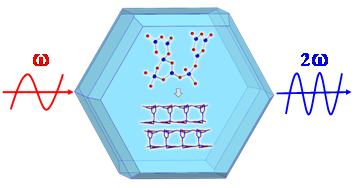Solid-state ultraviolet (UV) lasers are widely used for their various applications in commercial and scientific researches. The fourth harmonic generation (FHG) using nonlinear optical (NLO) crystals is an effective method to achieve a high-power UV laser at 266 nm. The borate crystals possessing wide transparency range, good chemical stability and high damage threshold, are promising candidates for the NLO applications. As a good UV material, several basic conditions should be satisfied: (1) a wide transparency window (absorption edge <300 nm); (2) a moderate birefringence (0.07–0.10); (3) a large second-harmonic generation (SHG) coefficient (>1 × KH2PO4 (KDP)). Owing to the mutual restriction among the band gap, birefringence, and NLO effect, achieving a balance among these three parameters in the design of new materials is still a huge challenge. In the past decades, many borates with excellent properties have been discovered. Among them, KBBF is the only NLO crystal that can generate SHG wavelength as short as 161 nm. Furthermore, only two NLO crystals are currently commercially available for the FHG at 266 nm: β-BaB2O4 (BBO) and CsLiB6O10 (CLBO). In response to the problems and challenges encountered in the development of ultraviolet nonlinear optical materials, a research group led by Prof. Shilie Pan at Xinjiang Technical Institute of Physics & Chemistry, Chinese Academy of Science, insists on exploring borate materials and continues to develop new high-performance ultraviolet nonlinear optical materials. Recently, the group successfully obtained a new cesium barium borate CsBaB9O15 (CBBO). The new fundamental building block (FBB) B9O19 was observed for the first time in this compound. CBBO has a layered structure similar to SBBO, and at the same time has an improvement on performance: (1) the two-dimensional double layer of CBBO is composed of B-O group, and its bond length is shorter than the Be-O bond in SBBO. The bond force is stronger, so the compound is much more stable, and the block crystals can be grown; (2) the structure contains planar B3O6 groups with large polarizability similar to the BBO crystal structure which tends to produce excellent performance; (3) the BeO4 unit was replaced by BO4 to completely solve the problem of toxic raw materials. In addition, Cs atoms in CBBO are filled in the holes of the B-O double layer, so the CBBO crystal should not be deliquescent. Related performance tests show that CBBO has excellent nonlinear optical properties, including a large SHG effect (3 times of KDP), a suitable birefringence (0.073@1064 nm) and deep-UV cutoff edge (175 nm), which demonstrate that CBBO is an excellent UV NLO material for the output of 266 nm laser. The paper was published in Science Bulletin with the title of “CsBaB9O15: a high performance ultraviolet nonlinear optical material activated by the peculiar double layered configuration”. This work was financially supported by National Natural Science Foundation of China, the Shanghai Cooperation Organization Science and Technology Partnership Program, and the International Partnership Program of Chinese Academy of Sciences.
Article link: https://doi.org/10.1016/j.scib.2021.06.025

Fig. 1. The B9O19 fundamental building block and the 2D double layers of CBBO. |
